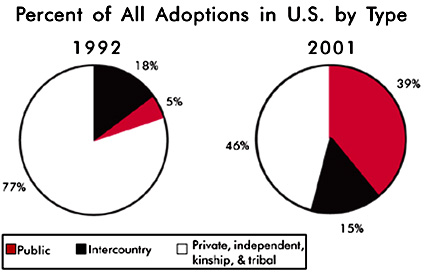|
Vol.
10, No. 1
December 2004
Supporting Adoptive Families
When it comes to finding adoptive families for children in foster care, North Carolina has a lot to celebrate. In 1990, there were just 126 foster care adoptions in our state (ACF, 2001). In 2000, there were more than 1,500 (NCDSS, 2004a). Thanks to this trend, there are now almost as many children in North Carolina receiving adoption assistance payments (that is, who have been adopted from foster care) as there are in foster care (NCDSS, 2004b).
Our achievement is echoed on a national level, where the annual number of adoptions from foster care increased from 25,644 in 1995 to 51,000 in 2000 (Christian, 2002). What’s more, researchers project that nationally the number of children adopted from foster care will continue to grow faster than the foster care population for at least the next 20 years (Wulczyn & Brunner, 2002).
We should be proud. Our society is beginning to embrace the notion that there is a family for every child. More importantly, we are expressing this belief in new laws, policies, funding, and ways of working.
Of course, “our” success depends entirely on the willingness of families to open their homes and hearts to children in foster care. “These families really are miracle workers,” says Sandy Cook, executive director of Children’s Home Society of North Carolina. A lot of what they accomplish with their children, she says, “is simply through common sense and love.”
But Cook and others familiar with adoption also know that for some adoptive families, love and common sense are not enough. To succeed with children adopted from foster care, the majority of whom have special needs and many of whom are older, families need ongoing support in various forms (Kramer & Houston, 1999). Indeed, there seems to be a strong relationship between supportive services and the health, well-being, and stability of adoptive families (Freundlich & Wright, 2003).
The importance of post-adoption services is reflected in the policy of North Carolina, whose county DSS’s are facilitating an increasing number of adoptions (see figure below). It says clearly that after the adoption, agencies continue to have “a moral obligation and a social responsibility for the welfare” of the children they helped become adopted (NCDSS, 2004c).
This issue of Practice Notes seeks to support you and your agency as you work to fulfill this crucial obligation.
Public Agency Adoptions on the Rise |
In FY 2000–2001, public agency adoptions accounted for approximately two-fifths of all adoptions, up from just 18% in 1992 (USDHHS, 2004). Though positive, this dramatic increase has implications for public agencies in North Carolina, which are responsible for supporting adoptive families.

Figure source: USDHHS, 2004
|
Contents
|
